A Framework of Dam-Break Hazard Risk Mapping for a Data-Sparse Region in Indonesia
Abstract
1. Introduction
2. Description of Case Study: Ketro Dam
2.1. Technical Data of the Dam
2.2. Catchment Area, Rainfall Data, and Other Measurement Values
2.3. Land Use Map
3. Methodology
3.1. Hydrology Data Uncertainty Analysis
3.2. Flood Discharge Design
3.3. Breach Flow Computation
3.4. Mathematical Model of NUFSAW2D
3.5. Flood Risk Mapping
4. Results and Analysis
4.1. Hydrology Analysis
4.2. Flood Propagation Modeling
4.3. Flood Risk Mapping Analysis
5. Conclusions
Author Contributions
Funding
Institutional Review Board Statement
Informed Consent Statement
Data Availability Statement
Acknowledgments
Conflicts of Interest
References
- Available online: https://www.liputan6.com/news/read/3926859 (accessed on 15 August 2020). (In Indonesian).
- Available online: https://news.detik.com/berita/d-2314491/bendungan-way-ela-di-maluku-tengah-jebol-1-orang-tewas-dan-32-terluka (accessed on 15 August 2020). (In Indonesian).
- Thieken, A.H.; Kienzler, S.; Kreibich, H.; Kuhlicke, C.; Kunz, M.; Mühr, B.; Müller, M.; Otto, A.; Petrow, T.; Pisi, S.; et al. Review of the flood risk management system in Germany after the major flood in 2013. Ecol. Soc. 2016, 21, 1–12. [Google Scholar] [CrossRef]
- Hofmann, J.; Schüttrumpf, H. Risk-based early warning system for pluvial flash floods: Approaches and foundations. Geosciences 2019, 9, 127. [Google Scholar] [CrossRef]
- González-Cao, J.; García-Feal, O.; Fernández-Nóvoa, D.; Domínguez-Alonso, J.M.; Gómez-Gesteira, M. Towards an automatic early warning system of flood hazards based on precipitation forecast: The case of the Miño River (NW Spain). Nat. Hazards Earth Syst. Sci. 2019, 19, 2583–2595. [Google Scholar] [CrossRef]
- Lin, L.; Wu, Z.; Liang, Q. Urban flood susceptibility analysis using a GIS-based multi-criteria analysis framework. Nat. Hazards 2019, 97, 455–475. [Google Scholar] [CrossRef]
- Available online: https://tandemx-science.dlr.de (accessed on 15 August 2020).
- Bhola, P.K.; Leandro, J.; Disse, M. Framework for offline flood inundation forecasts for two-dimensional hydrodynamic models. Geosciences 2018, 8, 346. [Google Scholar] [CrossRef]
- Ministry of Public Works and Housing. Laporan Pendahuluan: Penyiapan dan Penetapan Ijin Operasi Bendungan Cengklik, Delingan, dan Ketro Serta uji Model Fisik Bendungan Pacal; PT. Metanna Engineering Consultant; Ministry of Public Works and Housing: Konsultan, Bandung, Indonesia, 2020. (In Indonesian)
- McMillan, H.K.; Westerberg, I.K.; Krueger, T. Hydrological data uncertainty and its implications. WIREs Water 2018, 5, e1319. [Google Scholar] [CrossRef]
- McColl, K.A.; Vogelzang, J.; Konings, A.G.; Entekhabi, D.; Piles, M.; Stoffelen, A. Extended triple collocation: Estimating errors and correlation coefficients with respect to an unknown target. Geophys. Res. Lett. 2014, 41, 6229–6236. [Google Scholar] [CrossRef]
- Wu, X.; Xiao, Q.; Wen, J.; You, D. Direct comparison and triple collocation: Which is more reliable in the validation of coarse-scale satellite surface albedo products. J. Geophys. Res. Atmos. 2019, 124, 5198–5213. [Google Scholar] [CrossRef]
- Badan Standarisasi Nasional. Standar Nasional Indonesia: Tata Cara Perhitungan Debit Banjir Rencana; Badan Standarisasi Nasional: Pedoman, Jakarta, 2016. (In Indonesian)
- Hershfield, D.M. Rainfall Frequency Atlas of the United States; Weather Bureau, United States Department of Commerce: Washington, DC, USA, 1961.
- World Meteorological Organization. Manual on Estimation of Probable Maximum Precipitation (PMP); World Meteorological Organization: Geneve, Switzerland, 2009. [Google Scholar]
- Snyder, F.F. Synthetic unit-graphs. Trans. Am. Geophys. Union 1938, 19, 447–454. [Google Scholar] [CrossRef]
- United States Department of Agriculture. Urban Hydrology for Small Watersheds; Natural Resources Conservation Service, Conservation Engineering Division: Washington, DC, USA, 1986.
- Bureau of Reclamation. Design of Small Dams, 3rd ed.; Water Resources Technical Publication; US Department of the Interior: Washington, DC, USA, 1987.
- Chow, V.T.; Maidment, D.R.; Mays, L.W. Applied Hydrology; McGraw-Hill Publishing Company: New York, NY, USA, 1988. [Google Scholar]
- Harto, S. Analisis Hidrologi; PT. Gramedia Pustaka: Utama, Jakarta, 1993. (In Indonesian) [Google Scholar]
- Harto, S. Hidrologi: Teori, Masalah, Penyelesaian; Nafiri Offset: Yogyakarta, Indonesia, 2000. (In Indonesian) [Google Scholar]
- Ministry of Public Works and Housing. Buku Rencana Tindak Darurat Bendungan Delingan; PT. Dehas Inframedia Karsa; Ministry of Public Works and Housing: Konsultan, Jakarta, Indonesia, 2014. (In Indonesian)
- Ministry of Public Works and Housing. Laporan Akhir Penyusunan Rencana Tindak Darurat Bendungan Cengklik; PT. Dehas Inframedia Karsa; Ministry of Public Works and Housing: Konsultan, Jakarta, Indonesia, 2012. (In Indonesian)
- Available online: https://disc.gsfc.nasa.gov/datasets/TRMM_3B42_7/summary (accessed on 15 August 2020).
- Singh, K.P.; Snorrason, A. Sensitivity of outflow peaks and flood stages to the selection of dam breach parameters and simulation models. J. Hydrol. 1984, 64, 295–310. [Google Scholar] [CrossRef]
- MacDonald, T.C.; Langridge-Monopolis, J. Breaching charateristics of dam failures. J. Hydraul. Eng. (ASCE) 1984, 110, 567–586. [Google Scholar] [CrossRef]
- Von Thun, J.L.; Gillette, D.R. Guidance on Breach Parameters; U.S. Bureau of Reclamation: Denver, CO, USA, 1990; (Unpublished Internal Document).
- Froehlich, D.C. Embankment dam breach parameters revisited. In Proceedings of the 1st International Conference on Water Resources Engineering, Atlanta, Georgia, 5–8 June 1995; American Society of Civil Engineers: New York, NY, USA, 1995; pp. 887–891. [Google Scholar]
- Chinnarasri, C.; Jirakitlerd, S.; Wongwises, S. Embankment dam breach and its outflow characteristics. Civ. Eng. Environ. Syst. 2004, 21, 247–264. [Google Scholar] [CrossRef]
- Froehlich, D.C. Embankment dam breach parameters and their uncertainties. J. Hydraul. Eng. (ASCE) 2008, 13, 1708–1721. [Google Scholar] [CrossRef]
- Xu, Y.; Zhang, L.M. Breaching parameters for earth and rockfilldams. J. Geotech. Geoenviron. Eng. (ASCE) 2009, 135, 1957–1970. [Google Scholar] [CrossRef]
- De Lorenzo, G.; Macchione, F. Formulas for the peak discharge from breached earthfill dams. J. Hydraul. Eng. (ASCE) 2014, 140, 56–67. [Google Scholar] [CrossRef]
- Hood, K.; Perez, R.A.; Cieplinski, H.E.; Hromadka, T.V., II; Moglen, G.E.; McInvale, H.D. Development of an earthen dam break database. J. Am. Water Resour. Assoc. 2019, 55, 89–101. [Google Scholar] [CrossRef]
- Faeh, R. Numerical modeling of breach erosion of river embankments. J. Hydraul. Eng. (ASCE) 2007, 133, 1000–1009. [Google Scholar] [CrossRef]
- Wu, W.; Marsooli, R.; He, Z. A depth-averaged two-dimensional model of unsteady flow and sediment transport due to noncohesive embankment break/breaching. J. Hydraul. Eng. (ASCE) 2012, 138, 503–516. [Google Scholar] [CrossRef]
- Marsooli, R.; Wu, W. Numerical investigation of wave attenuation by vegetation using a 3D RANS model. Adv. Water Resour. 2014, 74, 245–257. [Google Scholar] [CrossRef]
- Fread, D.L. BREACH: An Erosion Model for Earthen Dam Failure (Model Description and User Manual); National Oceanic and Atmospheric Administration, National Weather Service: Silver Spring, MD, USA, 1988.
- Morris, M.W.; Kortenhaus, A.; Visser, P.J. Modelling Breach Initiation and Growth; FLOODsite: 2009. Available online: www.floodsite.net (accessed on 15 August 2020).
- Wu, W. Simplified physically based model of earthen embankment breaching. J. Hydraul. Eng. (ASCE) 2013, 139, 837–851. [Google Scholar] [CrossRef]
- Zhong, Q.; Wu, W.; Chen, S.; Wang, M. Comparison of simplified physically based dam breach models. Nat. Hazards 2016, 84, 1385–1418. [Google Scholar] [CrossRef]
- US Army Corps of Engineer. HEC-RAS User’s Manual 5.0; Hydrologic Engineering Center: Davis, CA, USA, 2016. Available online: https://www.hec.usace.army.mil/software/hec-ras/documentation/HEC-RAS%205.0%20Users%20Manual.pdf (accessed on 15 August 2020).
- Ginting, B.M.; Ginting, H. Extension of artificial viscosity technique for solving 2D non-hydrostatic shallow water equations. Eur. J. Mech. B Fluids 2020, 80, 92–111. [Google Scholar] [CrossRef]
- Ginting, B.M.; Bhola, P.K.; Ertl, C.; Mundani, R.P.; Disse, M.; Rank, E. Hybrid-parallel simulations and visualisations of real flood and tsunami events using unstructured meshes on high-performance cluster systems. In Advances in Hydroinformatics; Gourbesville, P., Caignaert, G., Eds.; Springer: Singapore, 2020; Chapter 67; pp. 867–888. [Google Scholar] [CrossRef]
- Ginting, B.M. Efficient Parallel Simulations of Flood Propagation Including Wet-Dry Problems. Ph.D. Thesis, Technische Universität München, Munich, Germany, 2019. Available online: https://mediatum.ub.tum.de/1518473 (accessed on 15 August 2020).
- Ginting, B.M.; Mundani, R.P. Comparison of shallow water solvers: Applications for dam-break and tsunami cases with reordering strategy for efficient vectorization on modern hardware. Water 2019, 11, 639. [Google Scholar] [CrossRef]
- Ginting, B.M.; Mundani, R.P. Parallel flood simulations for wet-dry problems using dynamic load balancing concept. J. Comput. Civ. Eng. (ASCE) 2019, 33, 04019013. [Google Scholar] [CrossRef]
- Ginting, B.M. Central-upwind scheme for 2D turbulent shallow flows using high-resolution meshes with scalable wall functions. Comput. Fluids 2019, 179, 394–421. [Google Scholar] [CrossRef]
- Ginting, B.M.; Ginting, H. Hybrid artificial viscosity–central-upwind scheme for recirculating turbulent shallow water flows. J. Hydraul. Eng. (ASCE) 2019, 145, 04019041. [Google Scholar] [CrossRef]
- Ginting, B.M.; Mundani, R.P. Artificial viscosity technique: A Riemann-solver-free method for 2D urban flood modelling on complex topography. In Advances in Hydroinformatics; Gourbesville, P., Cunge, J., Caignaert, G., Eds.; Springer: Singapore, 2018; Chapter 4; pp. 51–74. [Google Scholar] [CrossRef]
- Ginting, B.M.; Mundani, R.P.; Rank, E. Parallel simulations of shallow water solvers for modelling overland flows. In Proceedings of the 13th International Conference on Hydroinformatics, Palermo, Italy, 1–5 July 2018; La Loggia, G., Freni, G., Puleo, V., De Marchis, M., Eds.; EasyChair. EPiC Series in Engineering: Palermo, Italy, 2018; Volume 3, pp. 788–799. [Google Scholar] [CrossRef]
- Ginting, B.M. A two-dimensional artificial viscosity technique for modelling discontinuity in shallow water flows. Appl. Math. Model. 2017, 45, 653–683. [Google Scholar] [CrossRef]
- Kurganov, A.; Petrova, G. A second-order well-balanced positivity preserving central-upwind scheme for the Saint-Venant system. Commun. Math. Sci. 2007, 5, 133–160. Available online: https://projecteuclid.org/euclid.cms/1175797625 (accessed on 15 August 2020). [CrossRef]
- Brown, C.A.; Graham, W.J. Assessing the threat to life from dam failure. J. Am. Water Resour. Assoc. 1988, 24, 1303–1309. [Google Scholar] [CrossRef]
- DeKay, M.L.; McClelland, G.H. Predicting loss of life in cases of dam failure and flash flood. Risk Anal. 1993, 13, 193–205. [Google Scholar] [CrossRef]
- Li, Y.; Gong, J.; Zhu, J.; Song, Y.; Hu, Y.; Ye, L. Spatiotemporal simulation and risk analysis of dam-break flooding based on cellular automata. Int. J. Geogr. Inf. Sci. 2013, 27, 2043–2059. [Google Scholar] [CrossRef]
- Li, Z.K.; Li, W.; Ge, W. Weight analysis of influencing factors of dam break risk consequences. Nat. Hazards 2018, 18, 3355–3362. [Google Scholar] [CrossRef]
- Magilligan, F.J.; James, A.L.; Lecce, S.A.; Dietrich, J.T.; Kupfer, J.A. Geomorphic responses to extreme rainfall, catastrophic flooding, and dam failures across an urban to rural landscape. Ann. Am. Assoc. Geogr. 2019, 109, 709–725. [Google Scholar] [CrossRef]
- Ge, W.; Jiao, Y.; Sun, H.; Li, Z.; Zhang, H.; Zheng, Y.; Guo, X.; Zhang, Z.; van Gelder, P.H.A.J.M. A method for fast evaluation of potential consequences of dam breach. Water 2019, 11, 2224. [Google Scholar] [CrossRef]
- Albano, R.; Mancusi, L.; Adamowski, J.; Cantisani, A.; Sole, A. A GIS tool for mapping dam-break flood hazards in Italy. Int. J. Geo-Inf. 2019, 8, 250. [Google Scholar] [CrossRef]
- Available online: http://inasafe.org (accessed on 15 August 2020).
- Wallingford, H.R. R&D Outputs: Flood Risks to People; Technical Report. Available online: https://www.google.com/url?sa=t&rct=j&q=&esrc=s&source=web&cd=&ved=2ahUKEwiP_Zu29pDvAhXMzaQKHUQ3CdMQFjAAegQIARAD&url=http%3A%2F%2Frandd.defra.gov.uk%2FDocument.aspx%3FDocument%3DFD2321_3437_TRP.pdf&usg=AOvVaw3L0r7-5j2KqoaOaaLEkVK- (accessed on 24 November 2020).
- Viseu, T.; Betâmio de Almeida, A. Dam-break risk management and hazard mitigation. In WIT Transactions on State of the Art in Science and Engineering; WIT Press: Billerica, MA, USA, 2009; Volume 36, pp. 211–239. [Google Scholar] [CrossRef]
- Huff, F.A.; Neill, J.C. Frequency of point and areal mean rainfall rates. Eos Trans. AGU 1956, 37, 679–681. [Google Scholar] [CrossRef]
- Directorate General of Water Resources Development. Guideline for Dam Flood Safety; Technical Report; Ministry of Public Works: Jakarta, Indonesia, 1984.
- Yamazaki, D.; Ikeshima, D.; Sosa, J.; Bates, P.D.; Allen, G.H.; Pavelsky, T.M. MERIT Hydro: A high-resolution global hydrography map based on latest topography datasets. Water Resour. Res. 2019, 55, 5053–5073. [Google Scholar] [CrossRef]
- Available online: http://hydro.iis.u-tokyo.ac.jp/~yamadai/MERIT_Hydro/ (accessed on 15 August 2020).
- Saksena, S.; Merwade, V. Incorporating the effect of DEM resolution and accuracy for improved flood inundation mapping. J. Hydrol. 2015, 530, 180–194. [Google Scholar] [CrossRef]
- Hawker, L.; Bates, P.; Neal, J.; Rougier, J. Perspectives on digital elevation model (DEM) simulation for flood modeling in the absence of a high-accuracy open access global DEM. Front. Earth Sci. 2018, 6, 233. [Google Scholar] [CrossRef]
- Azizian, A.; Brocca, L. Determining the best remotely sensed DEM for flood inundation mapping in data sparse regions. Int. J. Remote Sens. 2019, 41, 1884–1906. [Google Scholar] [CrossRef]
- Available online: https://www.openstreetmap.org/#map=5/-2.546/118.016 (accessed on 15 August 2020).
- Available online: https://www.worldpop.org (accessed on 15 August 2020).
- Garrote, J.; Díez-Herrero, A.; Escudero, C.; García, I. A framework proposal for regional-scale flood-risk assessment of cultural heritage sites and application to the Castile and León Region (Central Spain). Int. J. Remote Sens. 2020, 12, 329. [Google Scholar] [CrossRef]
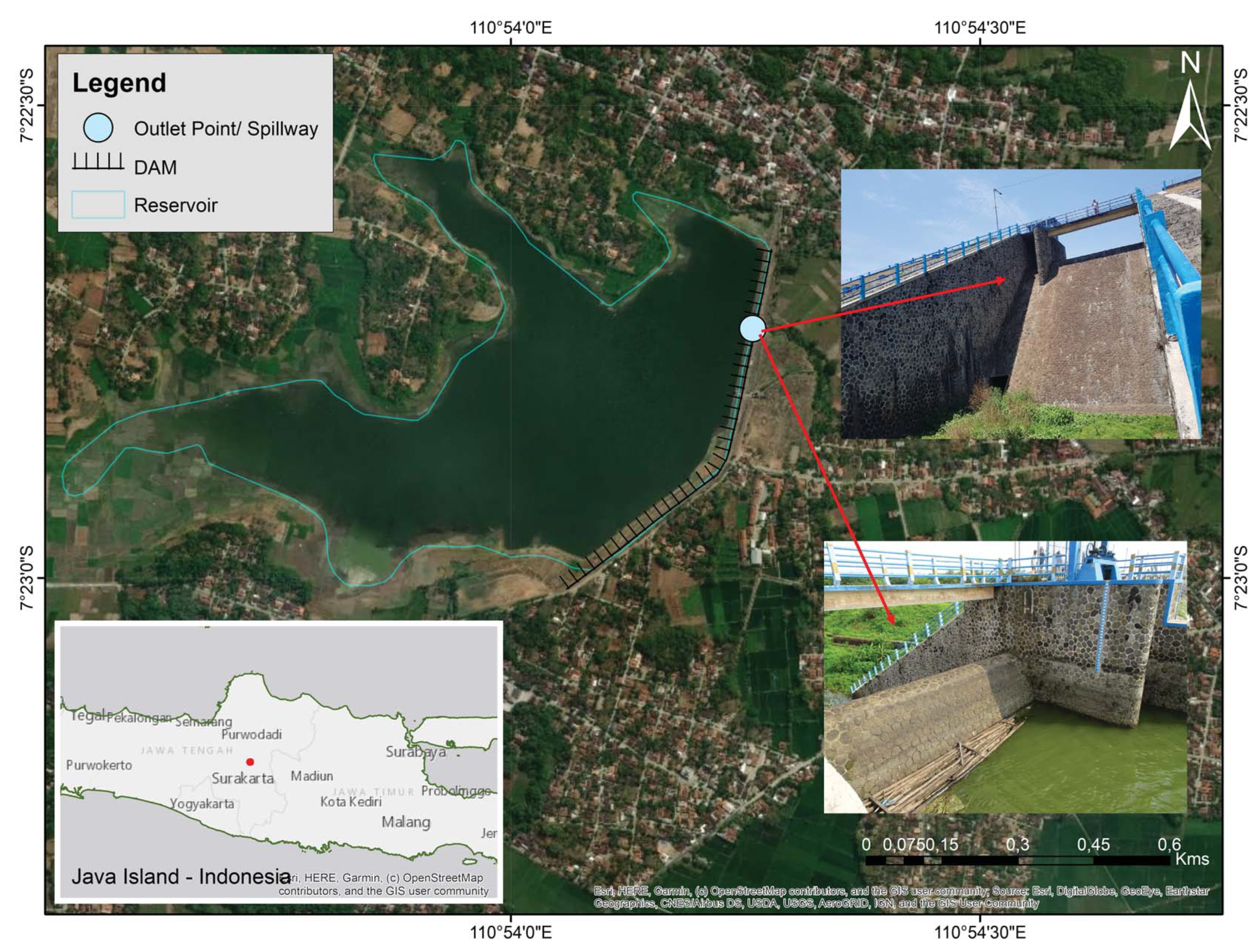
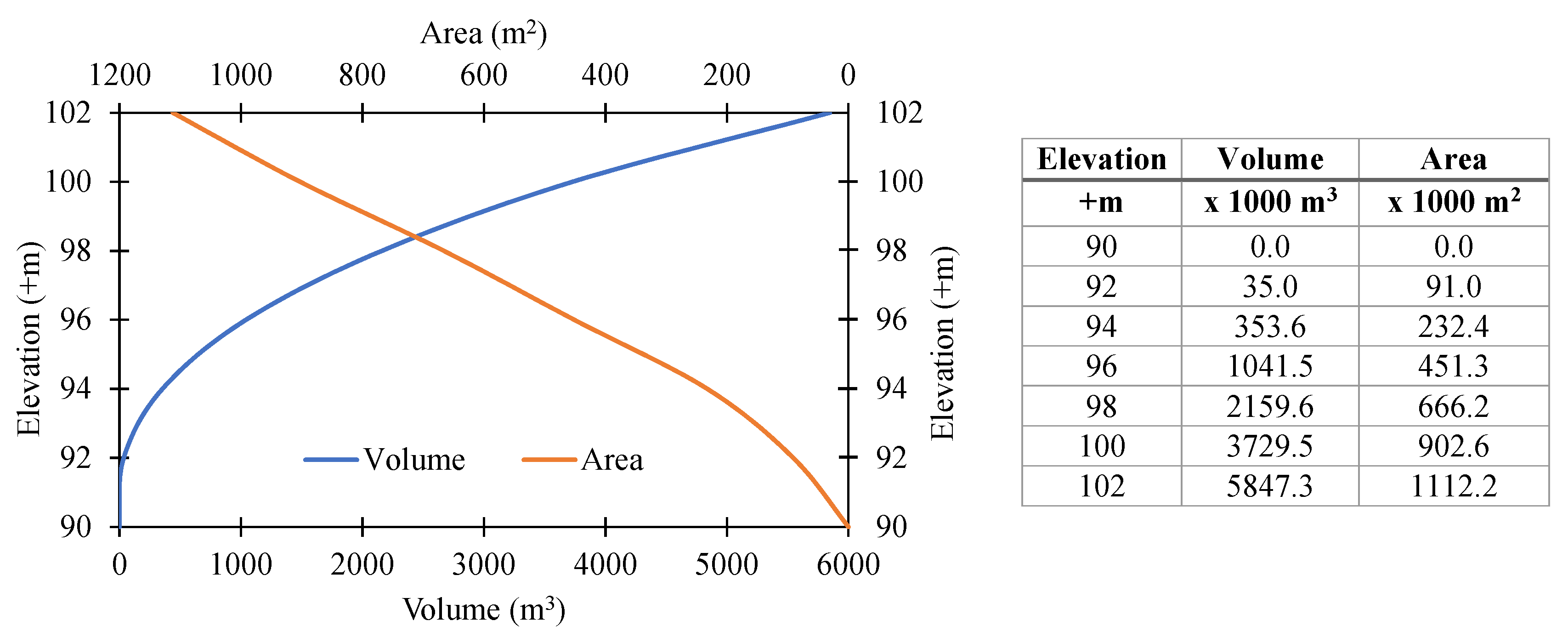
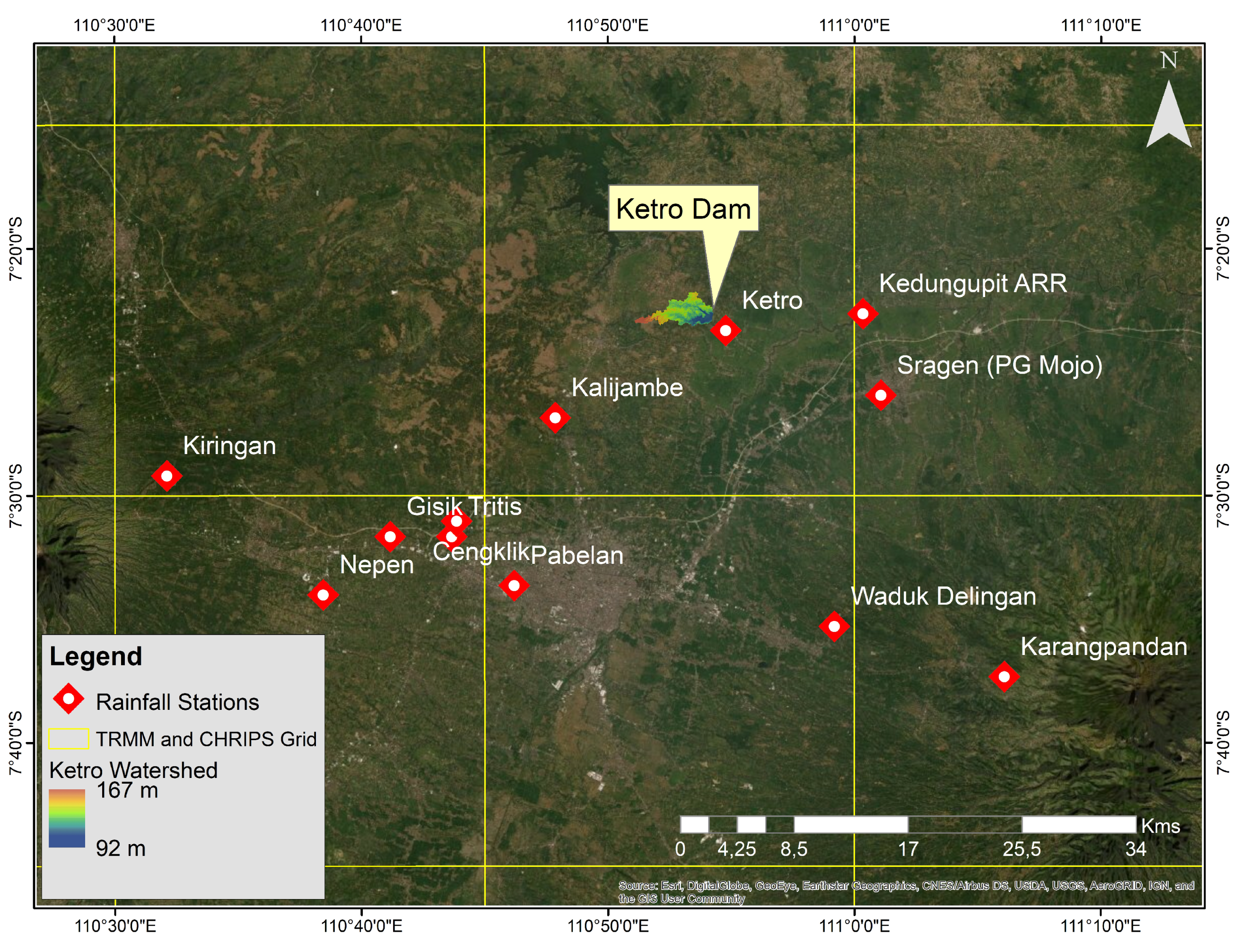
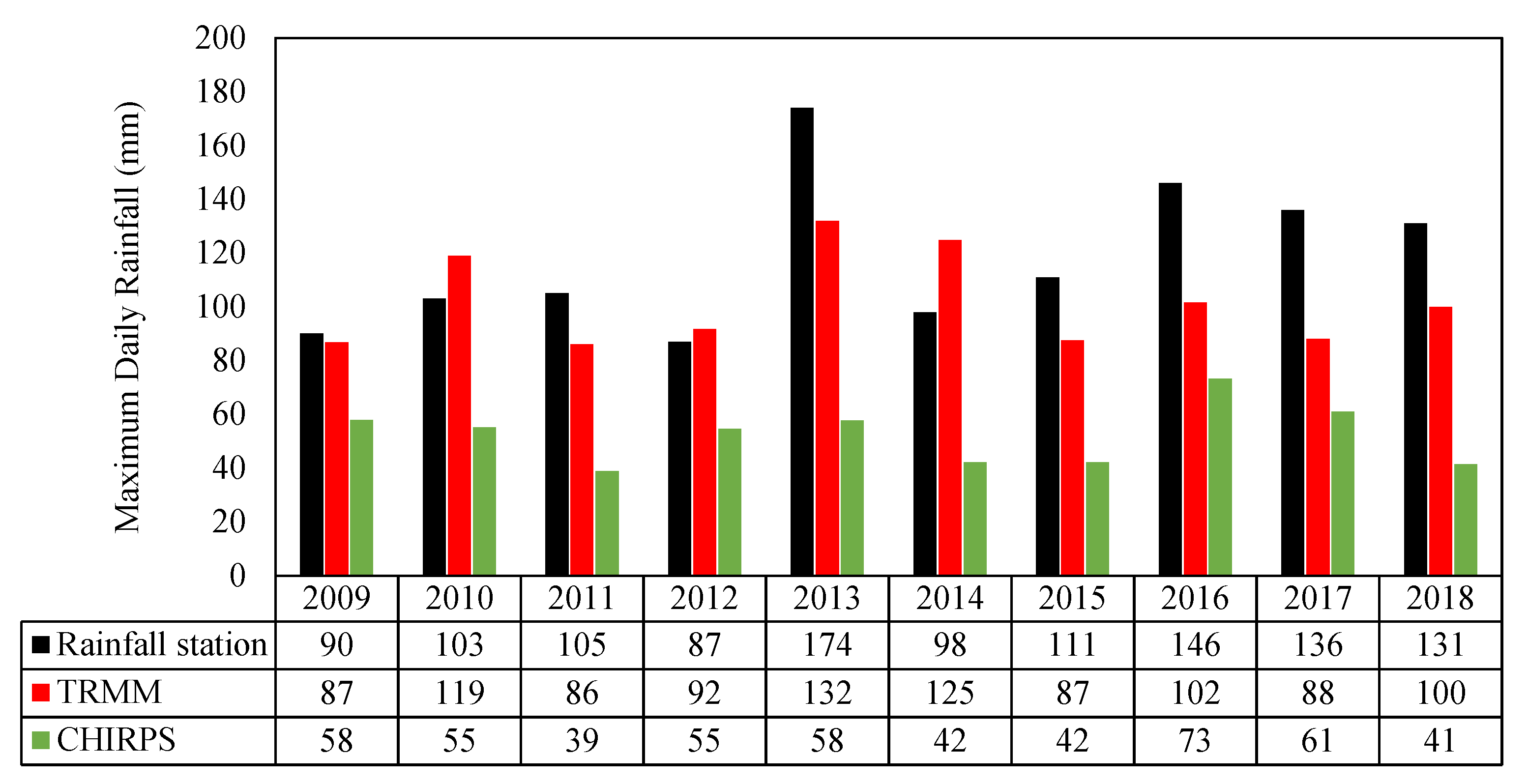
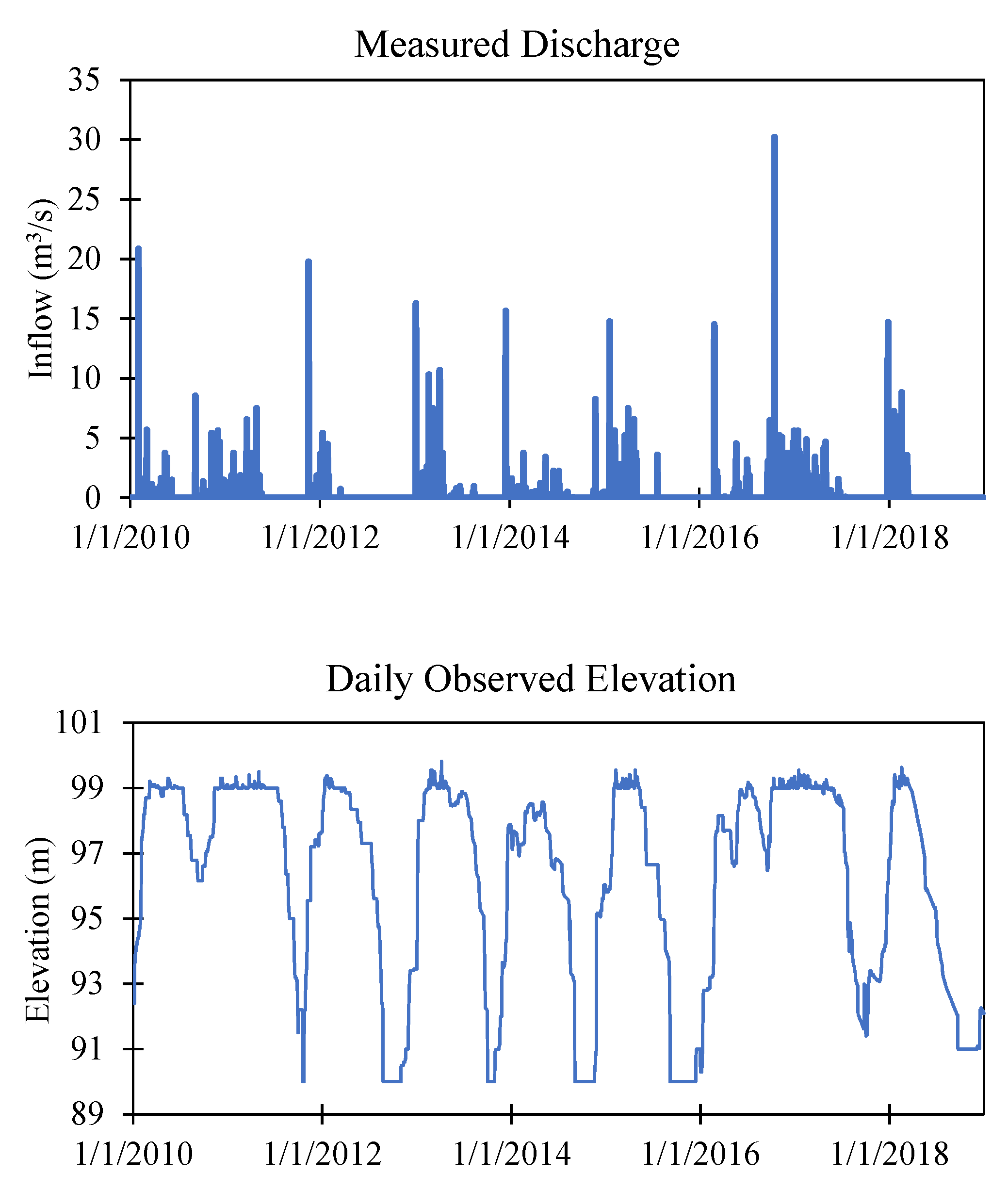
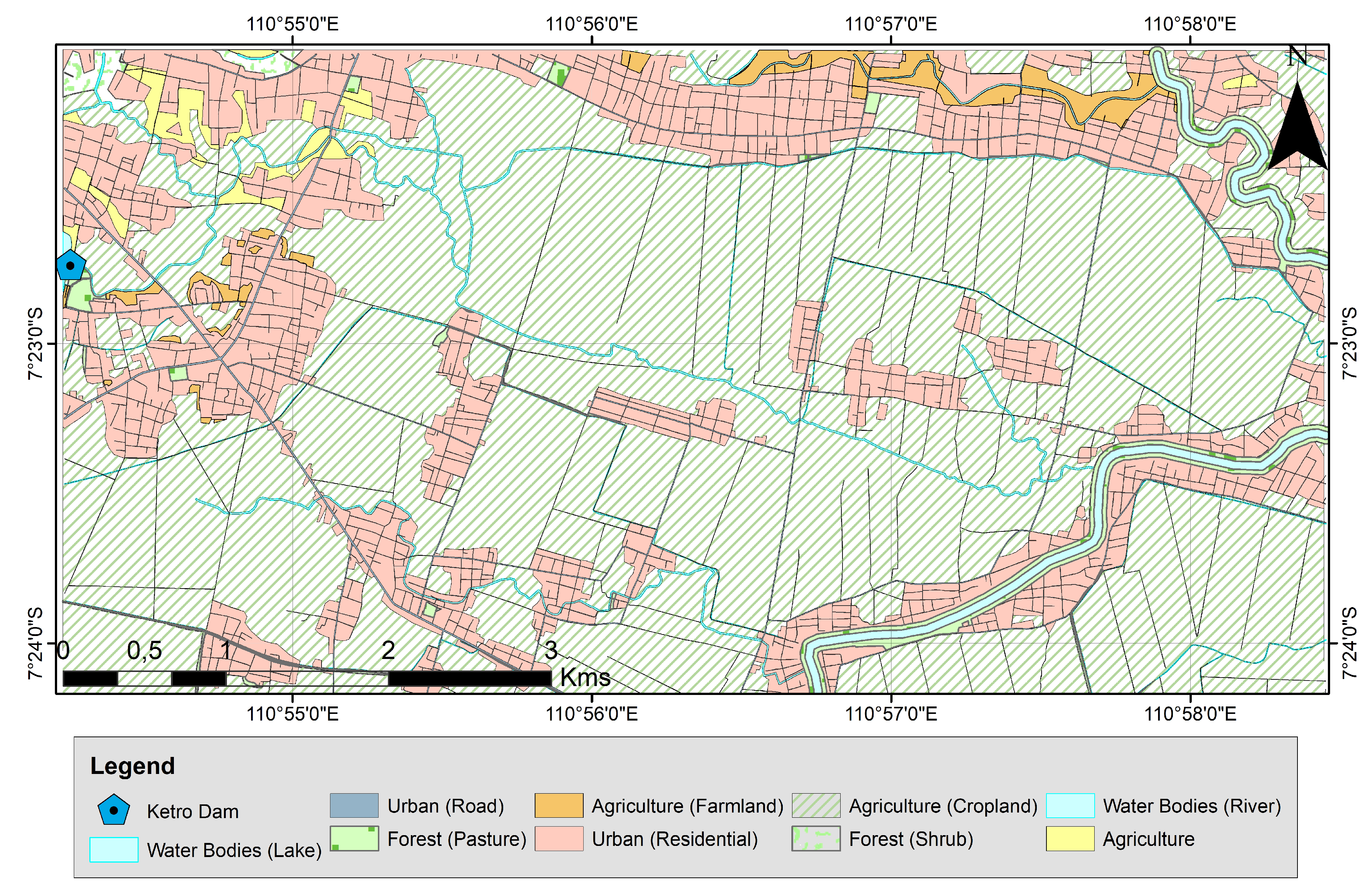
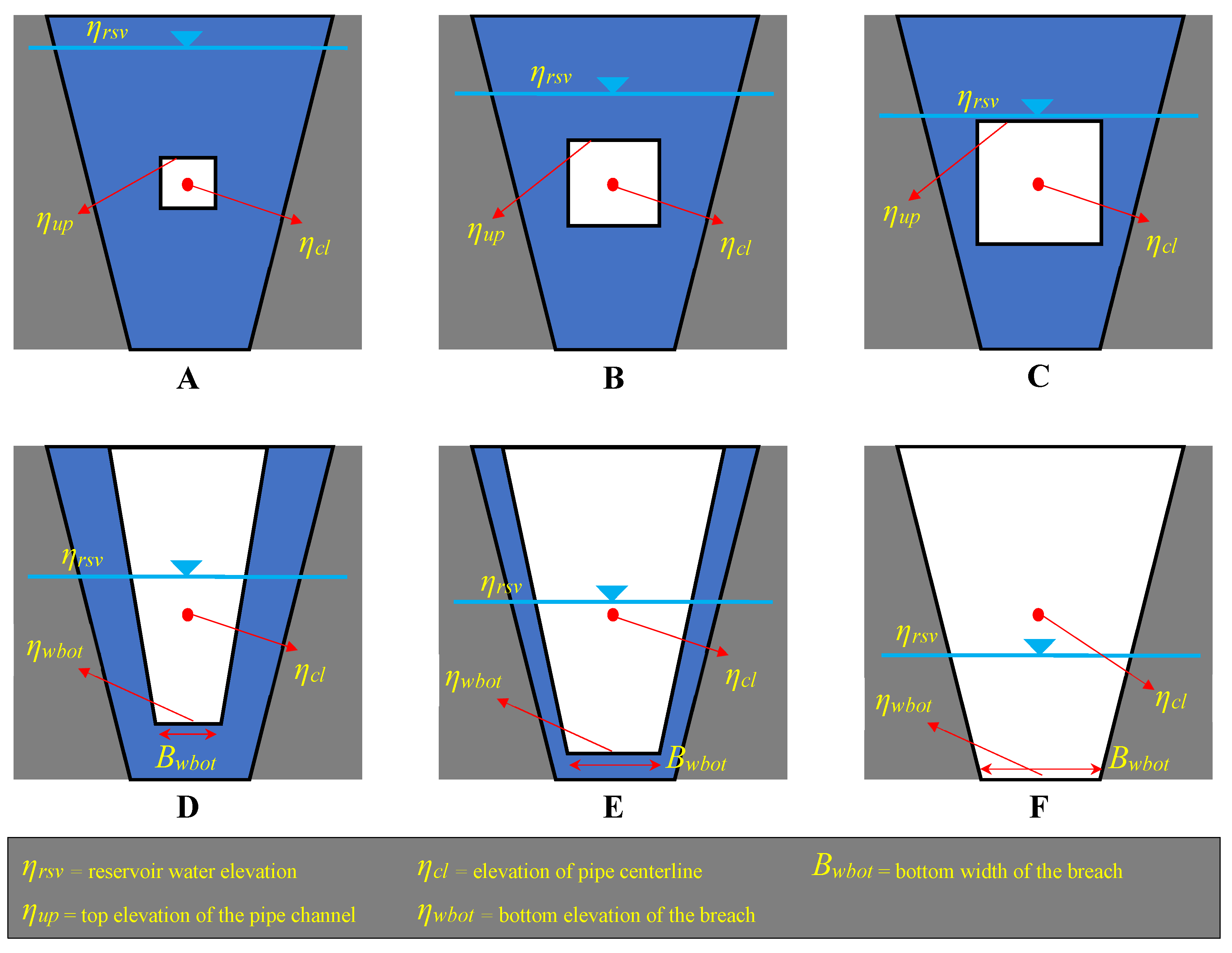
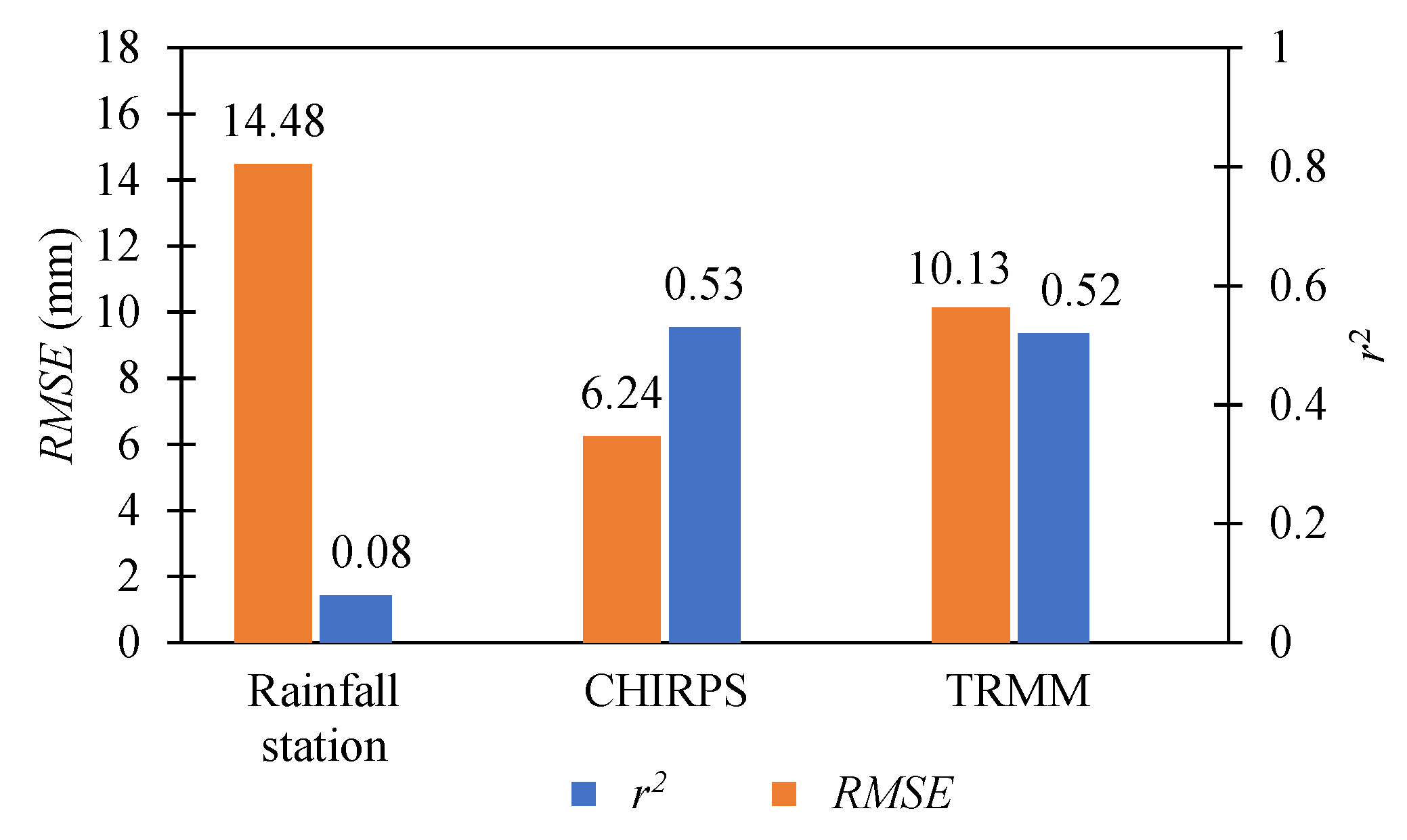

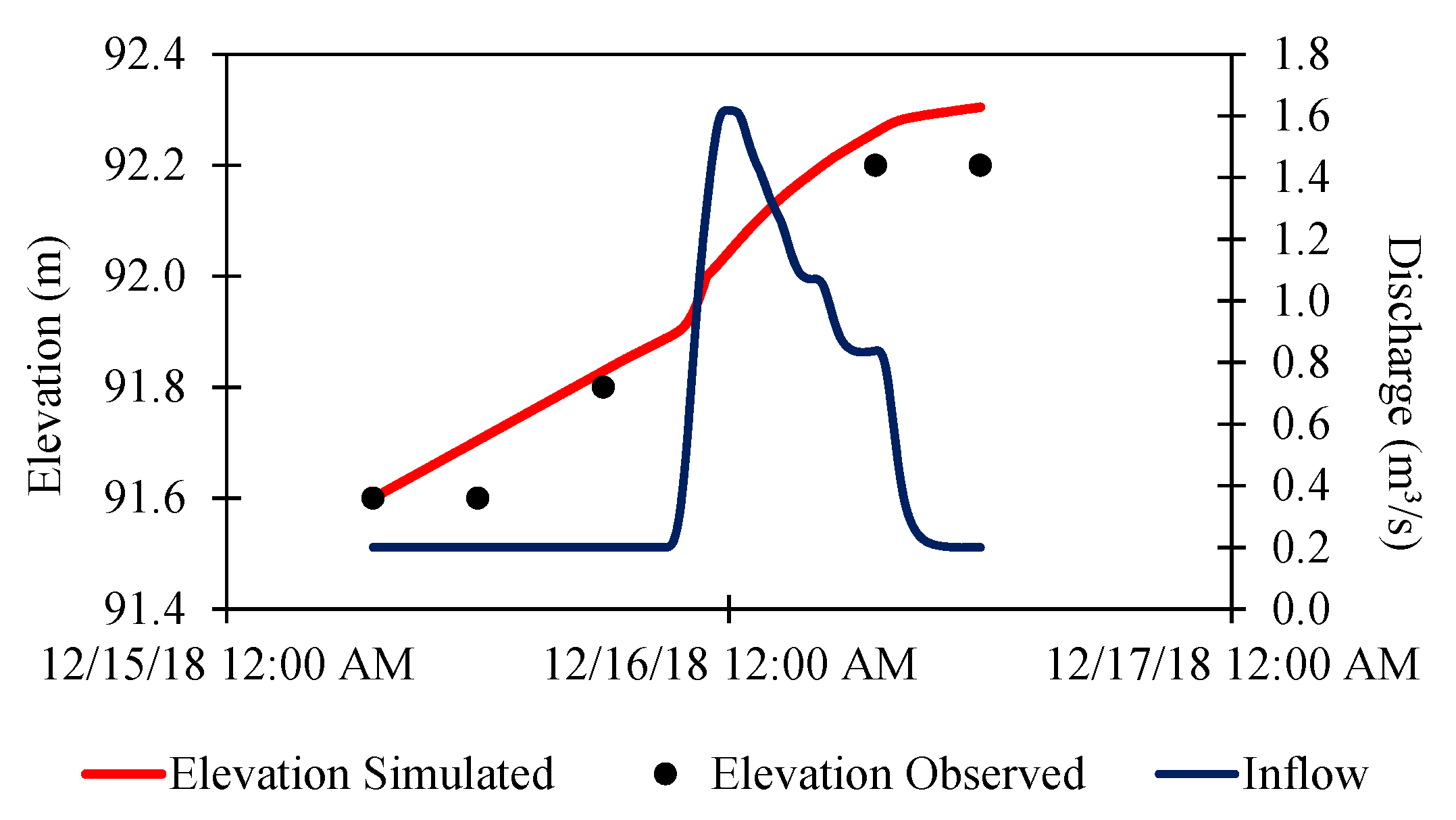
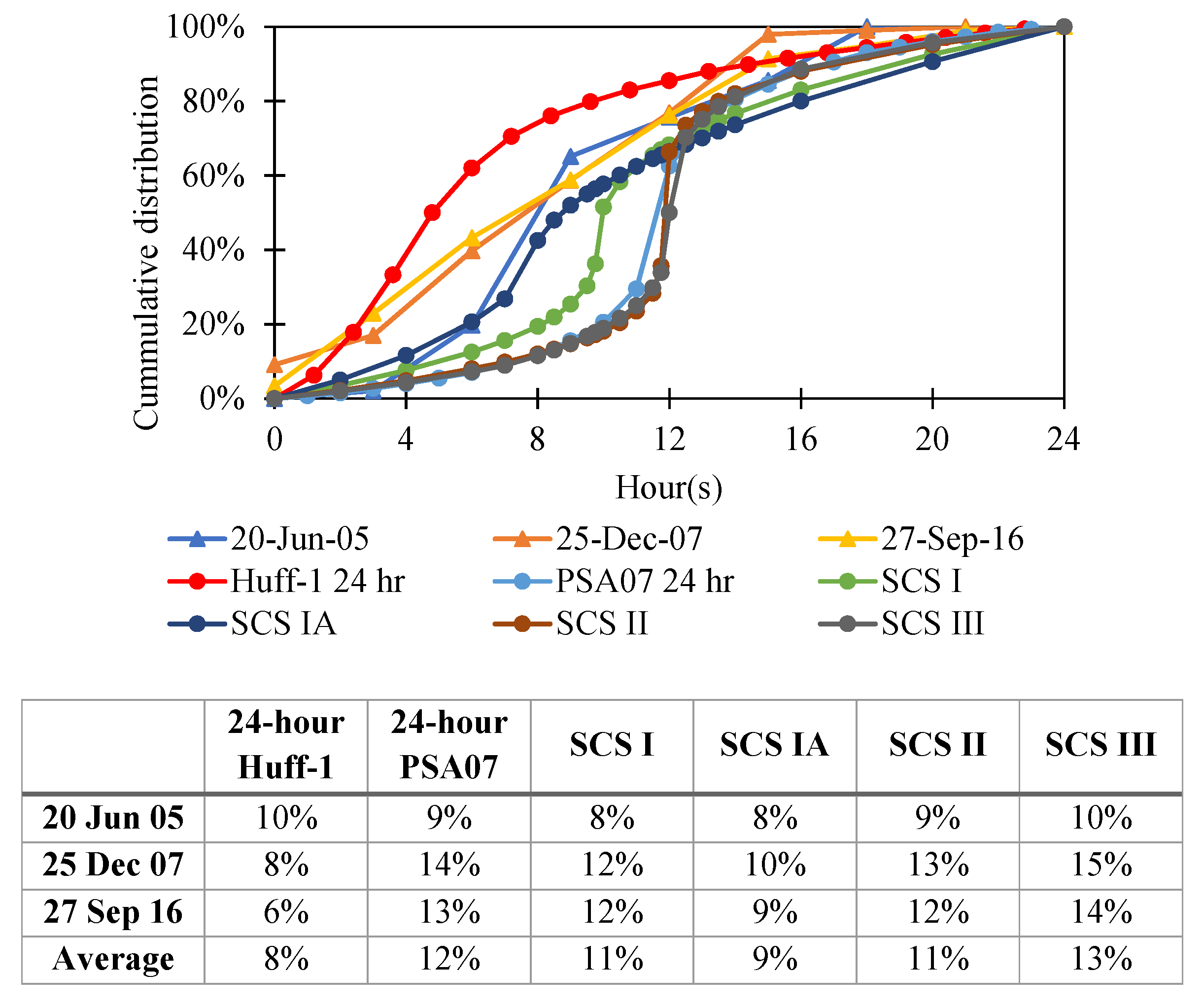
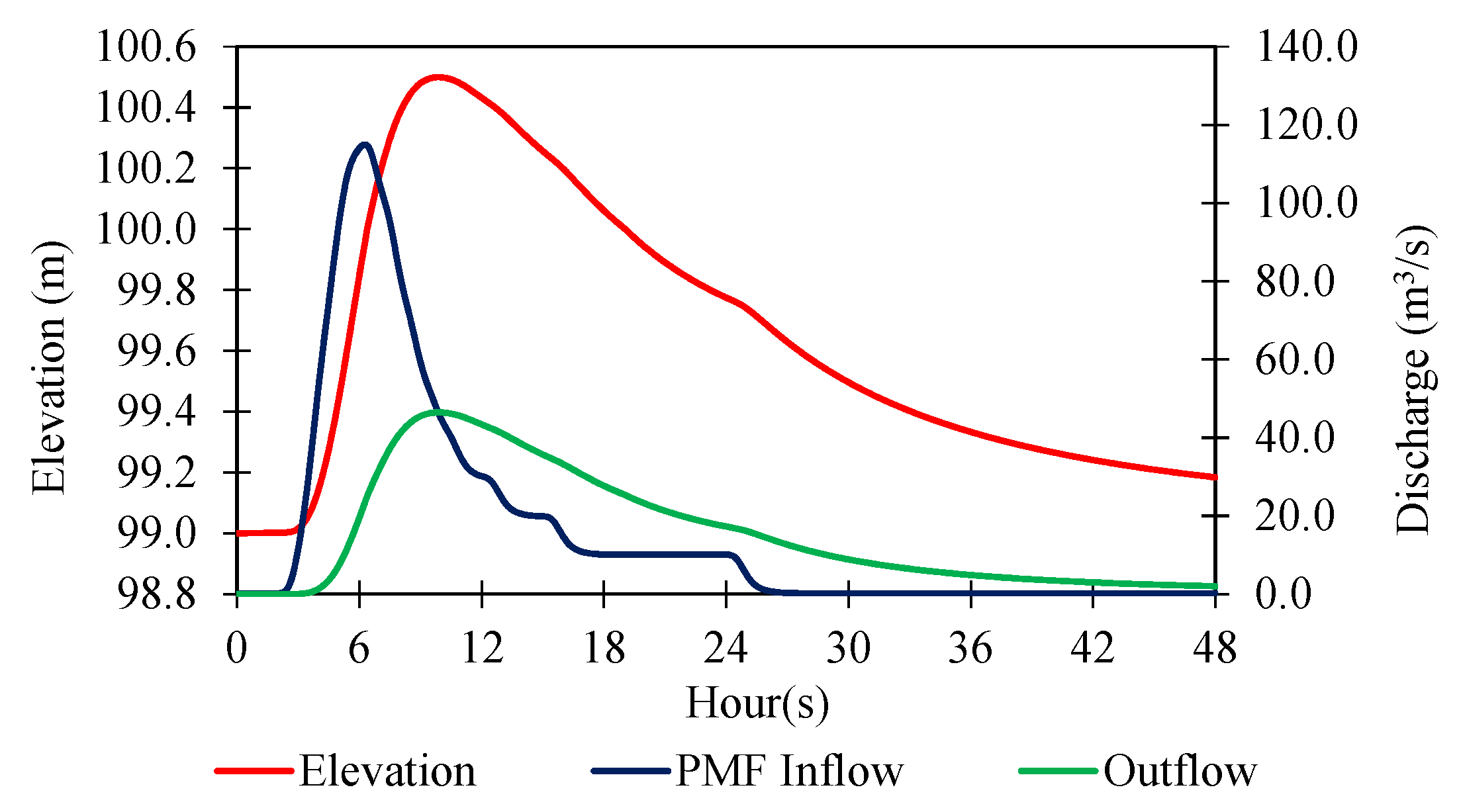

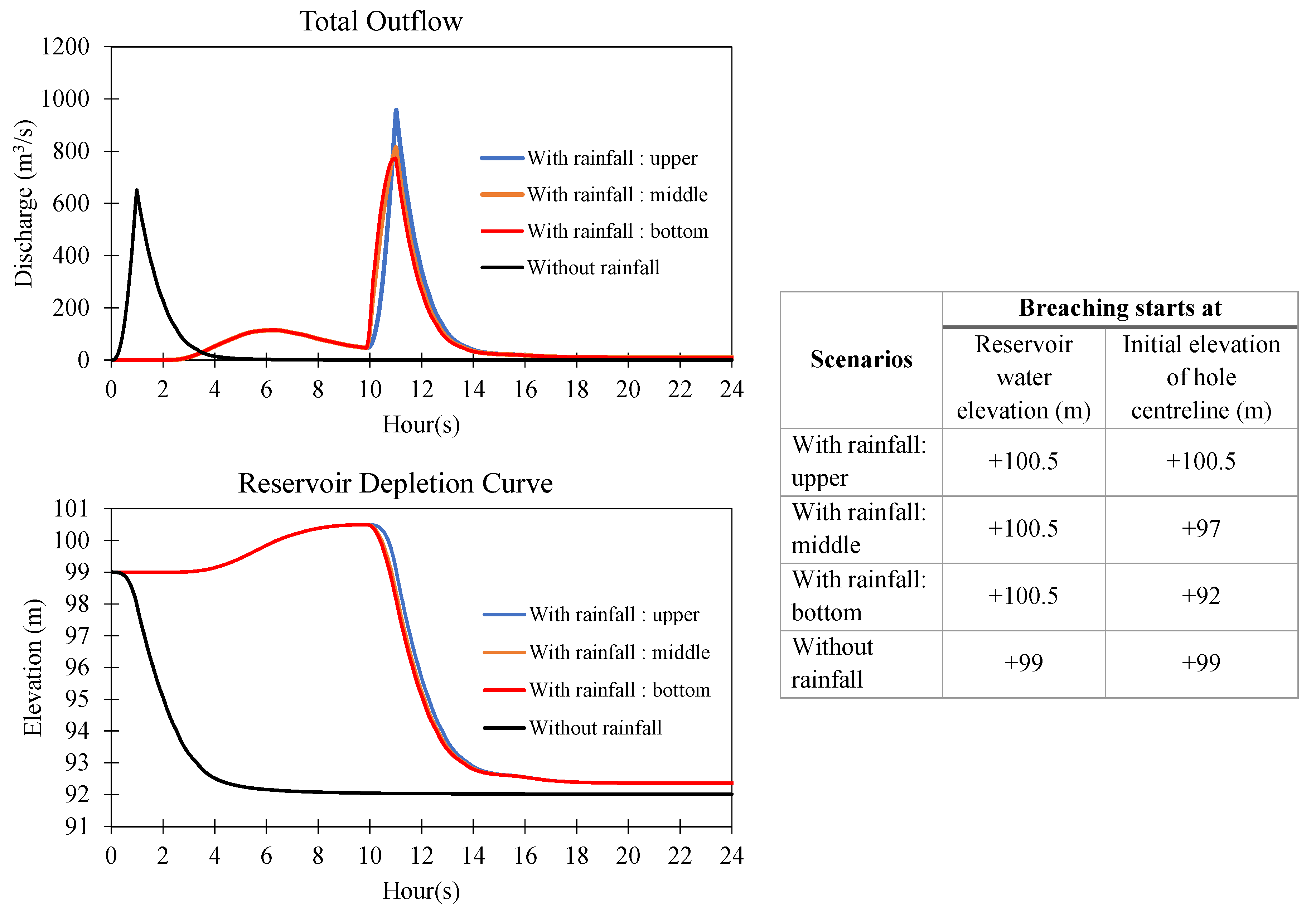
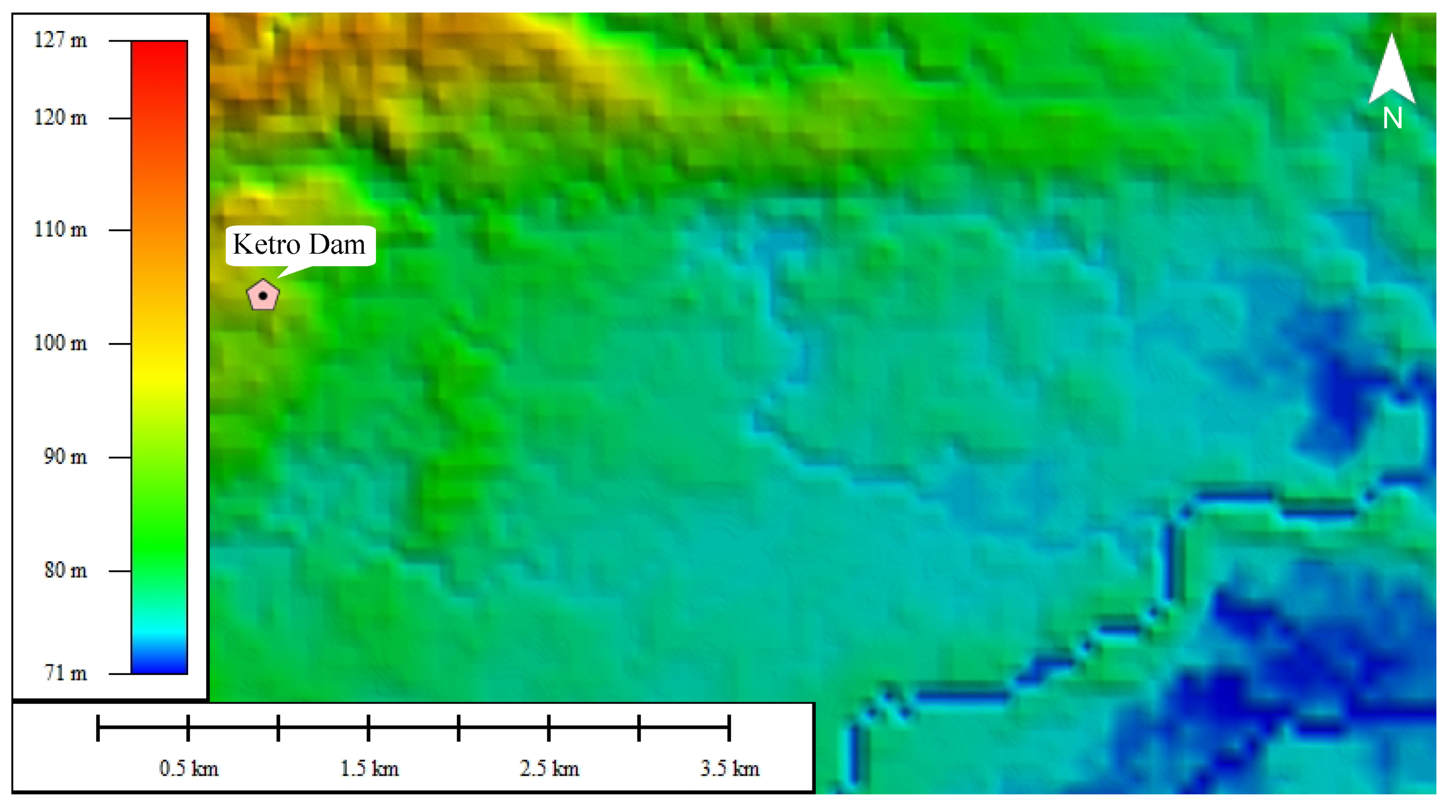
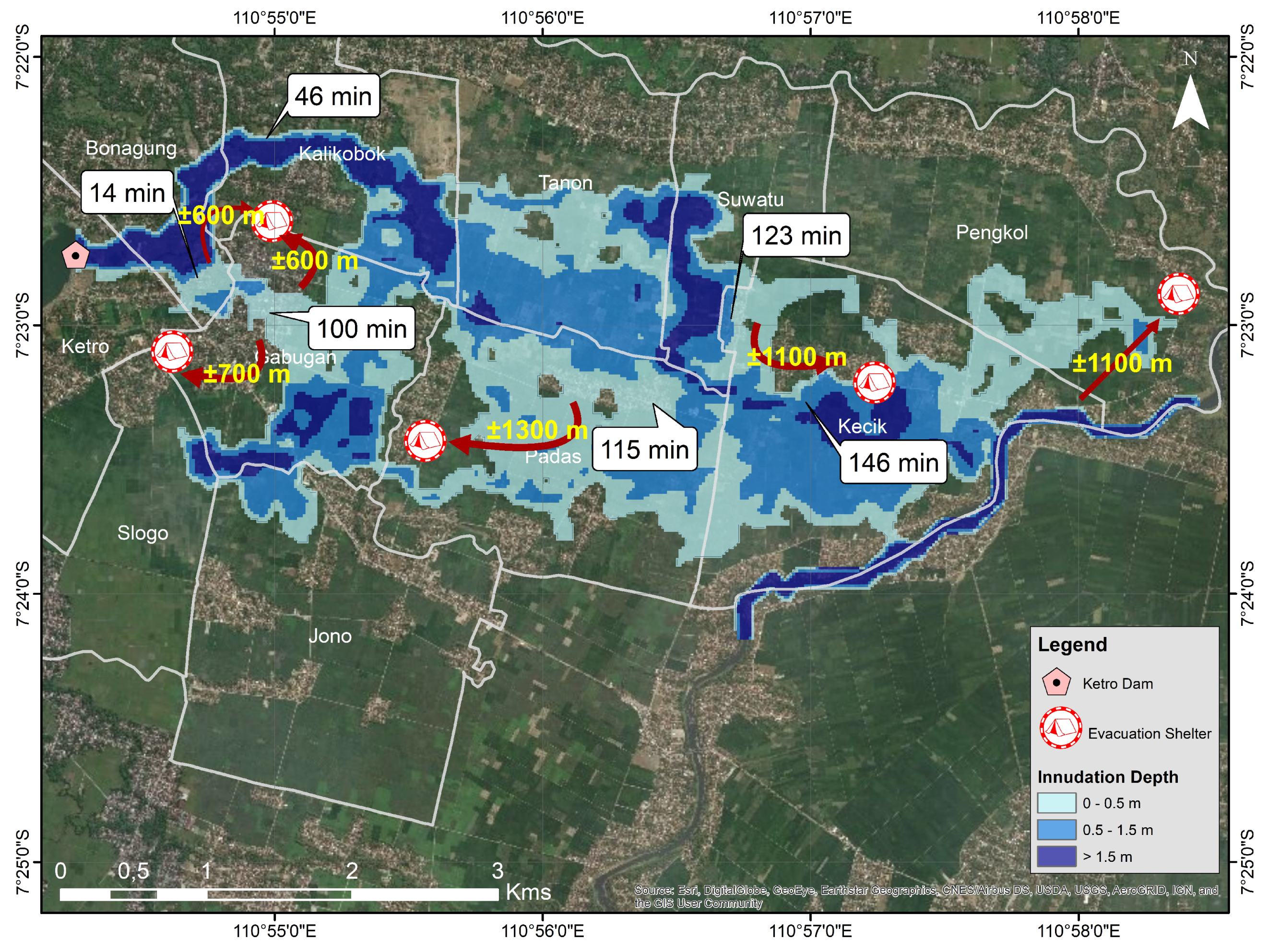
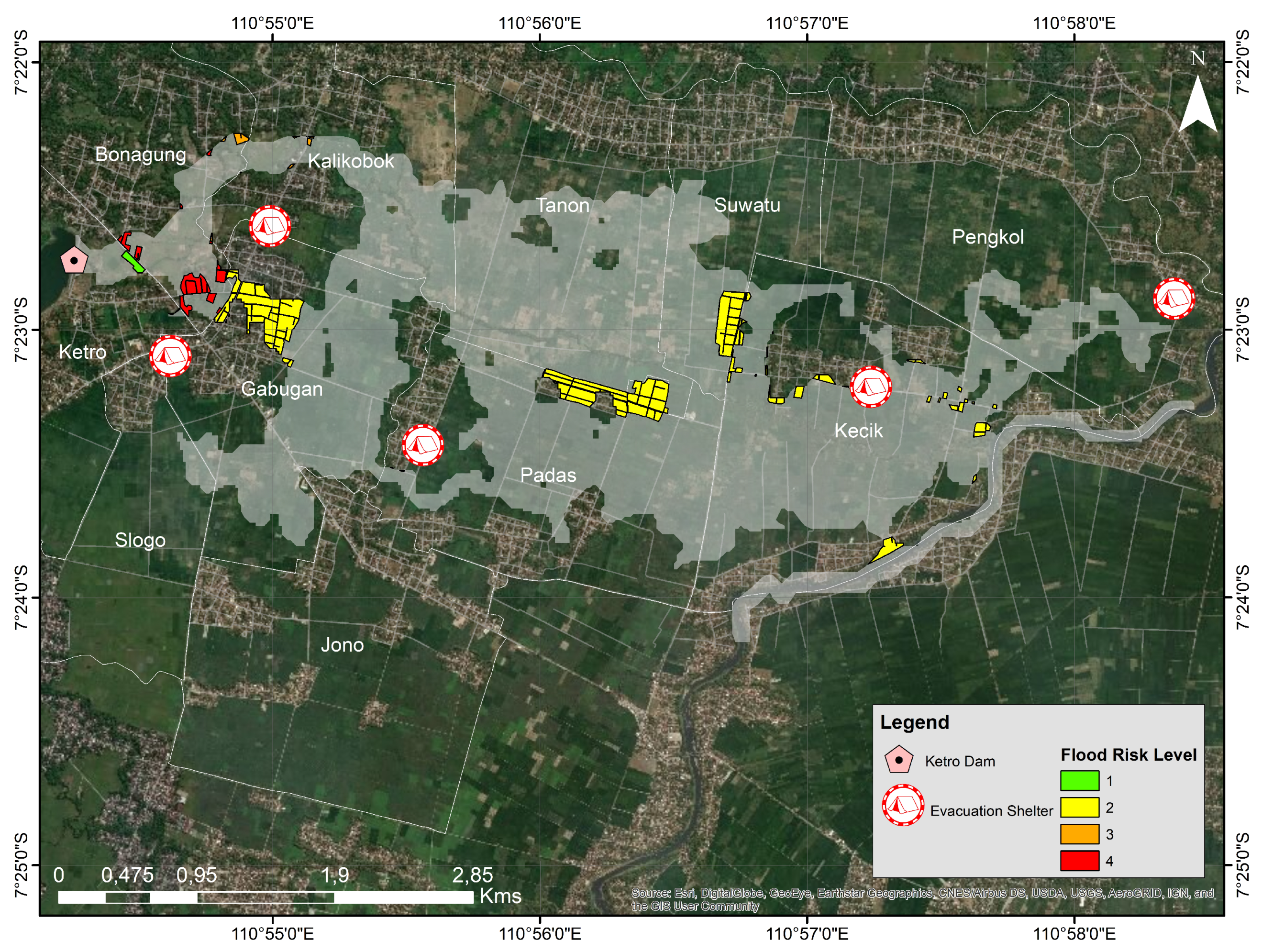
| Land Use | Range of Values (s/m) | Calibrated Values (s/m) |
|---|---|---|
| Water bodies | 0.015–0.149 | 0.022 |
| Agriculture | 0.025–0.110 | 0.043 |
| Forest | 0.110–0.200 | 0.189 |
| Transportation | 0.012–0.020 | 0.014 |
| Urban | 0.040–0.080 | 0.074 |
| Category | Aspect |
|---|---|
| Dam break flow characteristics | Inundation depth |
| Flow velocity | |
| Debris carried by the flow | |
| Evacuation efficiency | Average distance to the location |
| Vulnerable persons (children, elderly, and disabled) | |
| Road to access the location |
| Criteria | Pasture/Arable | Woodland | Urban |
|---|---|---|---|
| 0 m ≤ h < 0.25 m | 0 | 0 | 0 |
| 0.25 m ≤ h < 0.75 m | 0 | 0.5 | 1 |
| h≥ 0.75 m and/or > 2 m/s | 0.5 | 1 | 1 |
| Flood Factor (FF) | Degree of Danger | Description | Flood Hazard Index (FHI) |
|---|---|---|---|
| 0 ≤ FF ≤ 1.25 | Low | Caution | 1 |
| 1.25 < FF ≤ 1.75 | Moderate | Dangerous for some (i.e., children) | 2 |
| 1.75 < FF ≤ 3 | Significant | Dangerous for most people | 3 |
| FF > 3 | Extreme | Dangerous for all | 4 |
| Flood Risk Level (FRL) | Vulnerability Index (VI) | ||||
|---|---|---|---|---|---|
| 1 | 2 | 3 | 4 | ||
| Flood hazard index (FHI) | 1 | 1 | 1 | 2 | 2 |
| 2 | 1 | 2 | 2 | 3 | |
| 3 | 2 | 2 | 3 | 4 | |
| 4 | 2 | 3 | 4 | 4 | |
| Location | Range Class 1 <0.5 m | Range Class 2 0.5–1.5 m | Range Class 3 >1.5 m | Total |
|---|---|---|---|---|
| Bonagung | 174 | 172 | 295 | 611 |
| Gabugan | 861 | 685 | 273 | 1819 |
| Kalikobok | 157 | 234 | 352 | 743 |
| Kecik | 902 | 770 | 289 | 1961 |
| Ketro | 78 | 52 | 49 | 179 |
| Padas | 1084 | 546 | 23 | 1653 |
| Suwatu | 79 | 97 | 154 | 331 |
| Location | Flood Arrival Time (Min) | Distance to the Evacuation Place (m) | Distance / Time (m/s) |
|---|---|---|---|
| Bonagung | 14 | 600 | 0.72 |
| Gabugan | 100 | 700 | 0.12 |
| Kalikobok | 46 | 600 | 0.22 |
| Kecik | 146 | 1100 | 0.13 |
| Ketro | 60 | 600 | 0.17 |
| Padas | 115 | 1300 | 0.19 |
| Suwatu | 123 | 1100 | 0.12 |
| Location | Vulnerable Persons | Road Length (m) | ||
|---|---|---|---|---|
| Range Class 1 <0.5 m | Range Class 2 0.5–1.5 m | Range Class 3 >1.5 m | ||
| Bonagung | 45 | 37 | 77 | 2410 |
| Gabugan | 223 | 178 | 71 | 6658 |
| Kalikobok | 44 | 65 | 98 | 426 |
| Kecik | 252 | 215 | 81 | 13791 |
| Ketro | 22 | 15 | 14 | 219 |
| Padas | 303 | 153 | 6 | 10545 |
| Suwatu | 21 | 25 | 40 | 2332 |
| Classification for Coefficient | |||
|---|---|---|---|
| Normalized Ratio () | Value of | ||
| 0 ≤ ≤ 0.5 | 1 | ||
| 0.5 < ≤ 1 | 2 | ||
| 1 < ≤ 1.5 | 3 | ||
| > 1.5 | 4 | ||
| Classification for Coefficient VP | |||
| No. of Vulnerable People, VP | Range Class 1 <0.5 m | Range Class 2 0.5–1.5 m | Range Class 3 >1.5 m |
| 0 ≤ ≤ 50 | 0.2 × 1 | 0.3 × 1 | 0.5 × 1 |
| 50 < ≤ 150 | 0.2 × 2 | 0.3 × 2 | 0.5 × 2 |
| 150 < ≤ 250 | 0.2 × 3 | 0.3 × 3 | 0.5 × 3 |
| > 250 | 0.2 × 4 | 0.3 × 4 | 0.5 × 4 |
| Classification for CoefficientLR | |||
| Length of Road Inundated, L (m) | Value of | ||
| 0 ≤ L ≤ 1500 | 1 | ||
| 1500 < L ≤ 4500 | 2 | ||
| 4500 < L ≤ 6000 | 3 | ||
| L > 6000 | 4 | ||
| h (m) | (m/s) | DF | FF | FHI | NR | DL | VP | LR | VI | FRL | |
|---|---|---|---|---|---|---|---|---|---|---|---|
| Bonagung | 4.73 | 0.83 | 1 | 7.29 | 4 | 1.44 | 3 | 2 | 2 | 3 | 4 |
| Gabugan | 0.1 | 0.55 | 0 | 0.11 | 1 | 0.24 | 1 | 3 | 4 | 3 | 2 |
| Kalikobok | 2.74 | 0.77 | 1 | 4.48 | 4 | 0.44 | 1 | 2 | 1 | 2 | 3 |
| Kecik | 0.31 | 0.06 | 1 | 1.17 | 1 | 0.26 | 1 | 3 | 4 | 3 | 2 |
| Ketro | 0.64 | 0.47 | 1 | 1.62 | 2 | 0.34 | 1 | 1 | 1 | 1 | 1 |
| Padas | 0.14 | 0.33 | 0 | 0.12 | 1 | 0.38 | 1 | 3 | 4 | 3 | 2 |
| Suwatu | 1.01 | 0.12 | 1 | 1.63 | 2 | 0.3 | 1 | 1 | 1 | 2 | 2 |
Publisher’s Note: MDPI stays neutral with regard to jurisdictional claims in published maps and institutional affiliations. |
© 2021 by the authors. Licensee MDPI, Basel, Switzerland. This article is an open access article distributed under the terms and conditions of the Creative Commons Attribution (CC BY) license (http://creativecommons.org/licenses/by/4.0/).
Share and Cite
Yudianto, D.; Ginting, B.M.; Sanjaya, S.; Rusli, S.R.; Wicaksono, A. A Framework of Dam-Break Hazard Risk Mapping for a Data-Sparse Region in Indonesia. ISPRS Int. J. Geo-Inf. 2021, 10, 110. https://doi.org/10.3390/ijgi10030110
Yudianto D, Ginting BM, Sanjaya S, Rusli SR, Wicaksono A. A Framework of Dam-Break Hazard Risk Mapping for a Data-Sparse Region in Indonesia. ISPRS International Journal of Geo-Information. 2021; 10(3):110. https://doi.org/10.3390/ijgi10030110
Chicago/Turabian StyleYudianto, Doddi, Bobby Minola Ginting, Stephen Sanjaya, Steven Reinaldo Rusli, and Albert Wicaksono. 2021. "A Framework of Dam-Break Hazard Risk Mapping for a Data-Sparse Region in Indonesia" ISPRS International Journal of Geo-Information 10, no. 3: 110. https://doi.org/10.3390/ijgi10030110
APA StyleYudianto, D., Ginting, B. M., Sanjaya, S., Rusli, S. R., & Wicaksono, A. (2021). A Framework of Dam-Break Hazard Risk Mapping for a Data-Sparse Region in Indonesia. ISPRS International Journal of Geo-Information, 10(3), 110. https://doi.org/10.3390/ijgi10030110








